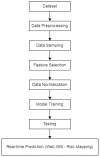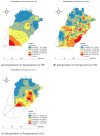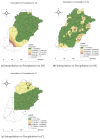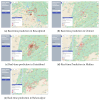WebGIS-Based Real-Time Surveillance and Response System for Vector-Borne Infectious Diseases
- PMID: 36834443
- PMCID: PMC9965707
- DOI: 10.3390/ijerph20043740
WebGIS-Based Real-Time Surveillance and Response System for Vector-Borne Infectious Diseases
Erratum in
-
Correction: Javaid et al. WebGIS-Based Real-Time Surveillance and Response System for Vector-Borne Infectious Diseases. Int. J. Environ. Res. Public Health 2023, 20, 3740.Int J Environ Res Public Health. 2025 Mar 26;22(4):499. doi: 10.3390/ijerph22040499. Int J Environ Res Public Health. 2025. PMID: 40207543 Free PMC article.
Abstract
The diseases transmitted through vectors such as mosquitoes are named vector-borne diseases (VBDs), such as malaria, dengue, and leishmaniasis. Malaria spreads by a vector named Anopheles mosquitos. Dengue is transmitted through the bite of the female vector Aedes aegypti or Aedes albopictus mosquito. The female Phlebotomine sandfly is the vector that transmits leishmaniasis. The best way to control VBDs is to identify breeding sites for their vectors. This can be efficiently accomplished by the Geographical Information System (GIS). The objective was to find the relation between climatic factors (temperature, humidity, and precipitation) to identify breeding sites for these vectors. Our data contained imbalance classes, so data oversampling of different sizes was created. The machine learning models used were Light Gradient Boosting Machine, Random Forest, Decision Tree, Support Vector Machine, and Multi-Layer Perceptron for model training. Their results were compared and analyzed to select the best model for disease prediction in Punjab, Pakistan. Random Forest was the selected model with 93.97% accuracy. Accuracy was measured using an F score, precision, or recall. Temperature, precipitation, and specific humidity significantly affect the spread of dengue, malaria, and leishmaniasis. A user-friendly web-based GIS platform was also developed for concerned citizens and policymakers.
Keywords: Geographical Information System; WebGIS; climate; machine learning; vector-borne disease.
Conflict of interest statement
The authors declare no conflict of interest.
Figures


















References
-
- Malaria D.O.F., Aand D., Vbds O. Management of Vector-Borne Diseases (VBDS) in Pakistan. [(accessed on 13 October 2021)]. Available online: https://www.google.com.hk/url?sa=t&rct=j&q=&esrc=s&source=web&cd=&cad=rj....
-
- Khan I., Mehmood S.A., Khan W., Ahmed S., Zia A., Khan N. Malaria Malaria in the Population District Dir Lower Khyber Pakhtunkhwa, Pakistan. RADS J. Pharm. Pharm. Sci. 2021;9:104–108. doi: 10.37962/jpps.v9i2.534. - DOI
-
- Askari S., Nateghpour M., Motevalli Haghi A., Farivar L., Raeisi A., Mohebali M. Situation of Asymptomatic Malaria among Iranian Native and Afghan and Pakistani Immigrants in a Malarious Area under the National Malaria Elimination Program of Iran. Iran. J. Parasitol. 2020;15:530–536. doi: 10.18502/ijpa.v15i4.4858. - DOI - PMC - PubMed
-
- Khatoon N., Malik R., Khan A., Shaukat S.S., Saifi Z.S., Khan A. Report: Incidence of malaria in the population of Korangi creek area, Karachi, Pakistan. Pak. J. Pharm. Sci. 2018;31:2575–2578. - PubMed
Publication types
MeSH terms
LinkOut - more resources
Full Text Sources
Medical

